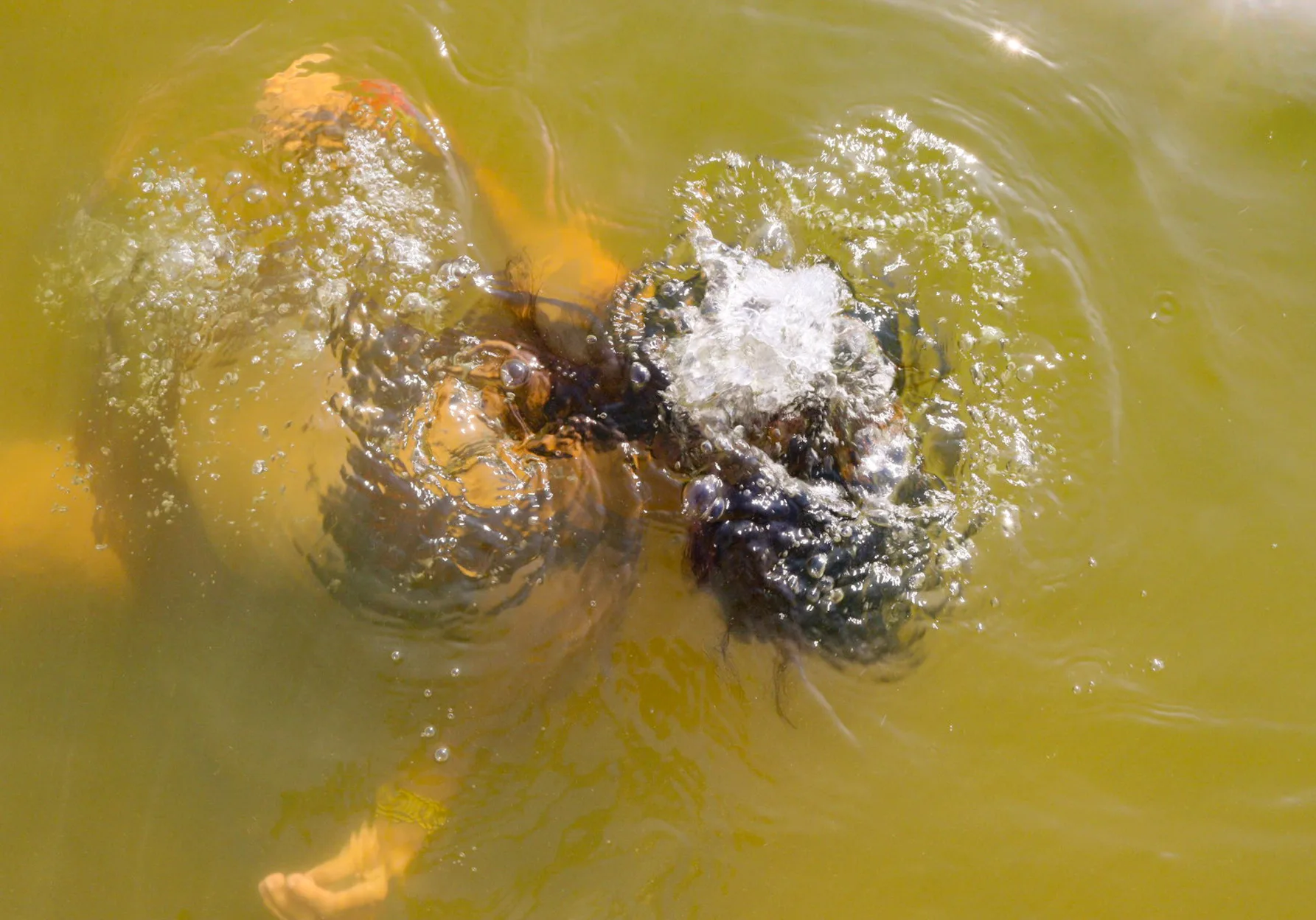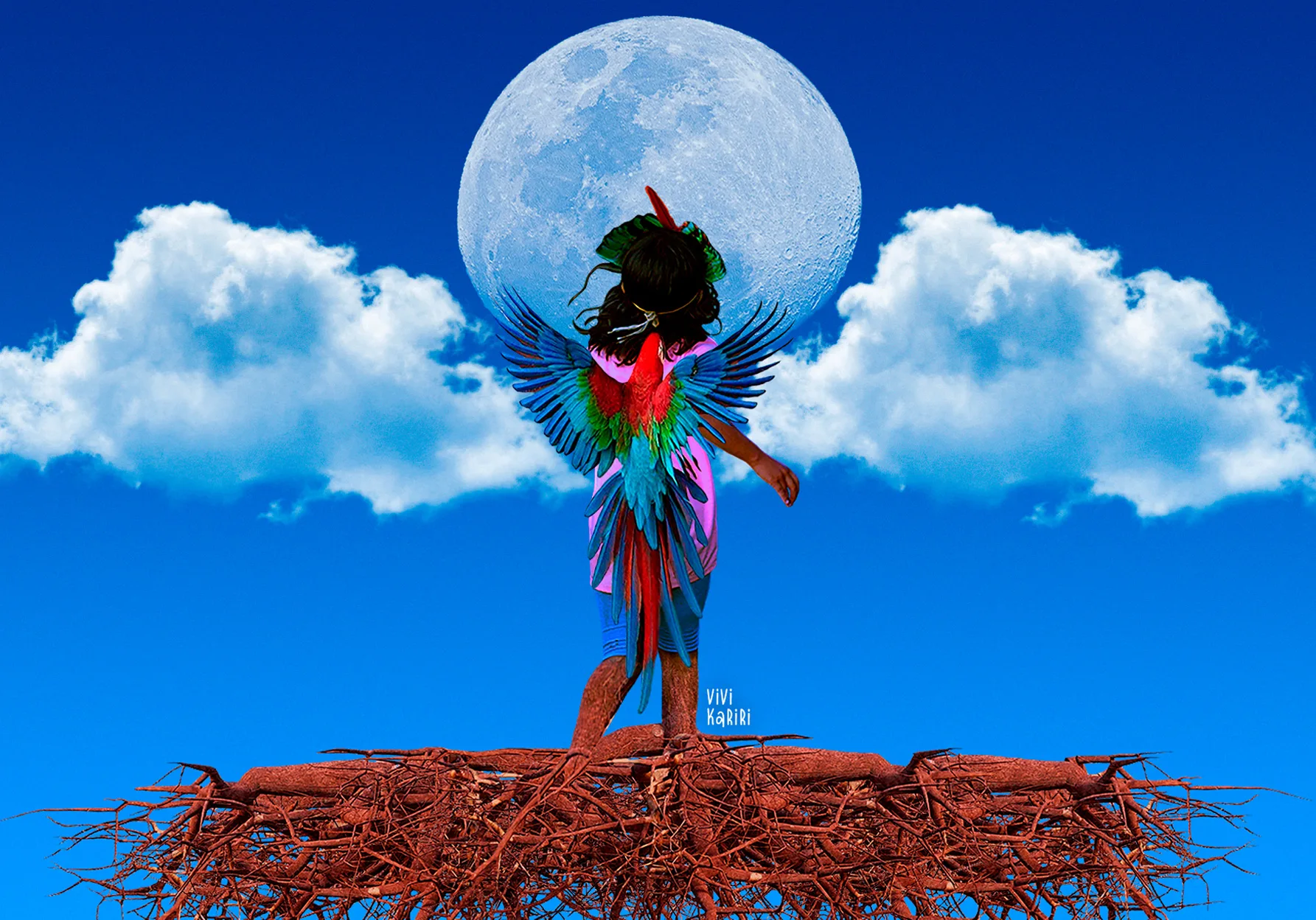A few months ago, a group of young French people surrounded Davi Kopenawa on the street in Cannes, in the south of France. They had been moved by the presence of the shaman and Yanomami leader on the European continent and, enchanted by his words, were eager to hear more. They had spent the previous three hours with him in a movie theater, where they had watched the recently premiered documentary The Falling Sky and participated in a conversation about the film. But those 180 minutes hadn’t been enough to satisfy the curiosity generated by a question asked in the early moments of the film: “Have you heard about the falling sky?”
Kopenawa was there to present the feature-length film at the Directors’ Fortnight, an event parallel to the Cannes Film Festival. The film, directed by Eryk Rocha and Gabriela Carneiro da Cunha, was based on the book of the same name, written by Kopenawa and French anthropologist Bruce Albert, in which the two authors deliver a remarkable autobiographical account of Yanomami life and this people’s constant struggle, since the 1960s, against the threat of the napëpë (white people). The ideas expressed in the book, written more than a decade ago and now brought to the screen, are even more relevant today.
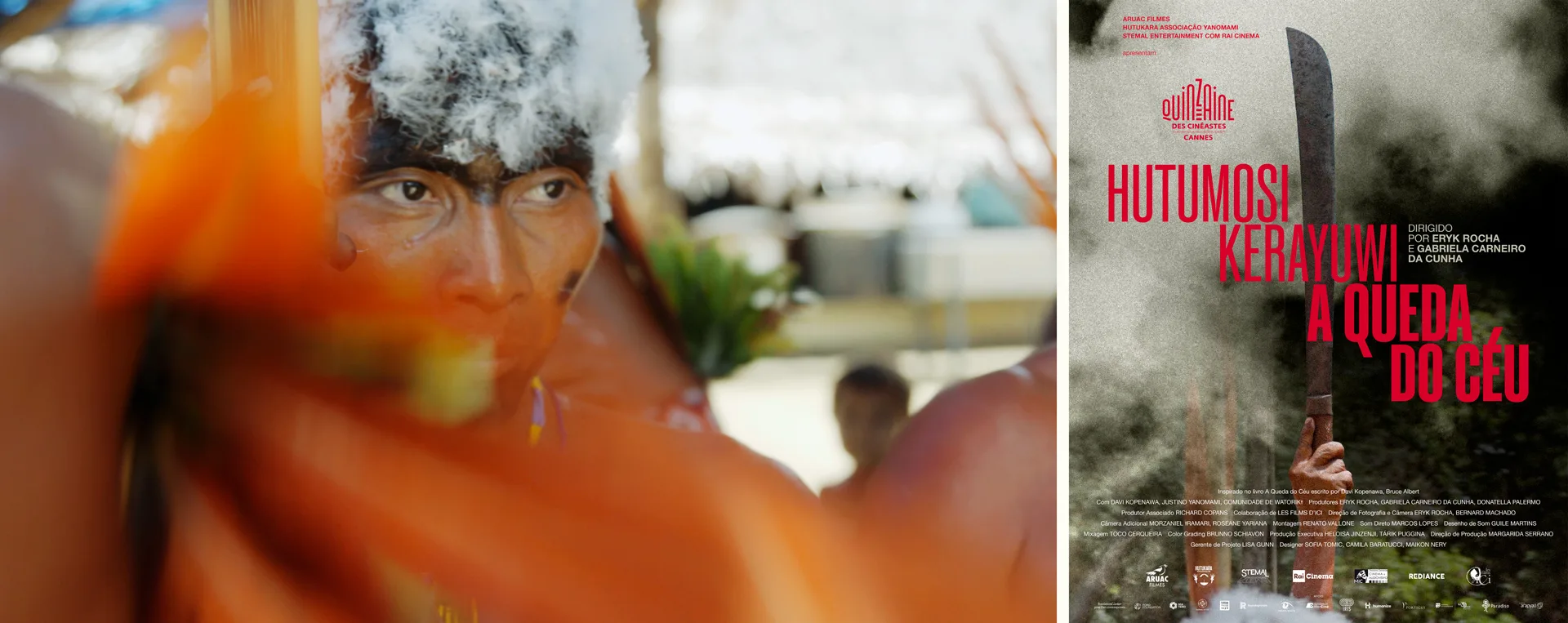
The documentary The Falling Sky was inspired by the book of the same name written by Albert and Kopenawa. Photos: Movie still and poster
“After the sky fell for the first time, the great xapiripë spirits raised the sky up again. It will happen again. (…),” Kopenawa says in the film. “Today, miners and ranchers are destroying the forest-earth everywhere. So these ancient beings are again getting angrier and angrier. But as long as there are shamans, they’ll hold up the sky. But for how long?”
During his latest trip around the world to denounce the ongoing destruction of the Amazon Forest, Kopenawa, along with Bruce Albert and the filmmakers, took part in presentations of the documentary. There were five screenings in total during the festival, all of which ended in applause from the audience. But the night the young people surrounded Davi Kopenawa, the shaman was truly convinced his message was being heard. “They were kids around 13, 14 years old. At the end, during the discussion inside the cinema, Davi argued that they needed to know how to see and respect what they were watching,” Gabriela said.
The documentary, narrated by Kopenawa, is structured around a reahu celebration, the Yanomami funeral rite where relatives gather to erase traces of the deceased, lead them into oblivion, and thus allow their spirit to settle in the world of the dead. Both the book and the film invite napëpë to experience Yanomami customs, activities, and cosmology in a strategy to sensitize non-Indigenous people to the values rooted in forest peoples. Perhaps this way they might also internalize the urgent need to halt the destruction of Nature.
“The Yanomami have a very comfortable relationship with death. They are highly aware of impermanence, of the idea that [life] is a transmission [of knowledge] from one generation to the next. That’s why they’re so cheerful and so devoid of egotism and excessive narcissism. They know everyone has to give their children a sense of direction in the world, a groundedness, that’s just how it is. They don’t get too hung up on themselves. The same way they don’t like to own too many things,” said Albert in a conversation with Kopenawa, Eryk, and Gabriela after one of the film screenings in Cannes. “Once you’ve cried, erased the traces, the dead person is gone, and you are free. They’re not tied to the dead like us, with cemeteries, etc. That leaves a heavy burden on us. They have a naturalness about death, which is why they place a very high value on life, and particularly the generosity of passing on knowledge.”
This idea of exploring the relationships between Yanomami mothers, children, and shamans was embraced by the film’s directors, who respected the pace of the forest and took seven years to complete their work. That was the only way to capture important moments in the lives of the Indigenous people, such as the series of stages in the “erasure” of a dead person, body painting techniques, the rituals for inhaling the hallucinogenic powder yãkoana, and radio conversations between peoples to warn each other of approaching gold miners.
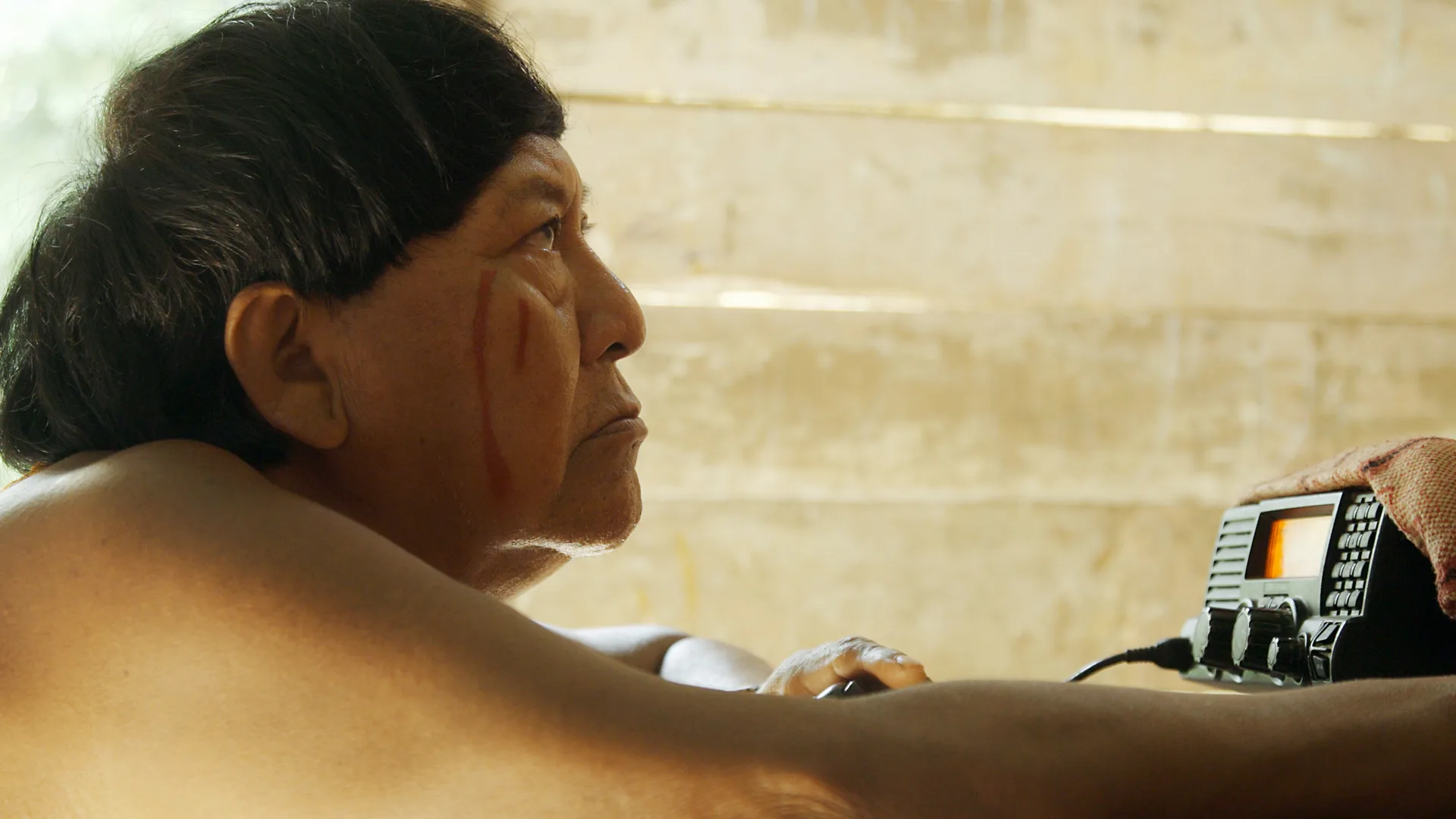
Some scenes in the movie show the Yanomami facing the threat of invasion by miners. Photo: Still from the documentary
Though the shaman narrates the film, which still doesn’t have a premier date in Brazil, Eryk explains that during the editing process, they slowly began “emptying out the words to get to what was most essential, so the film could breathe. Then Davi’s voice could be one voice, a character mixed in with all of the others, in a polyphony, a multiplicity of beings. [The idea was] to lend force and vitality to this polyglot forest, placing Davi Kopenawa’s voice among the voices of the birds, the winds, the thunder, the river.”
Gabriela says that after the mostly young audience had seen the film, she, co-director Eryk, and Davi Kopenawa were talking on the sidewalk when a group of about 60 boys and girls approached the shaman and started applauding loudly. “They wanted to continue the conversation right there. It was a very powerful moment because Cannes is the largest film festival in the world, and it’s also a place where many international stars come. So to see the admiration young Europeans had for Davi, their desire to listen to him, to see him, to continue the exchange in the middle of the street, was very special. He felt his words were being embraced.”
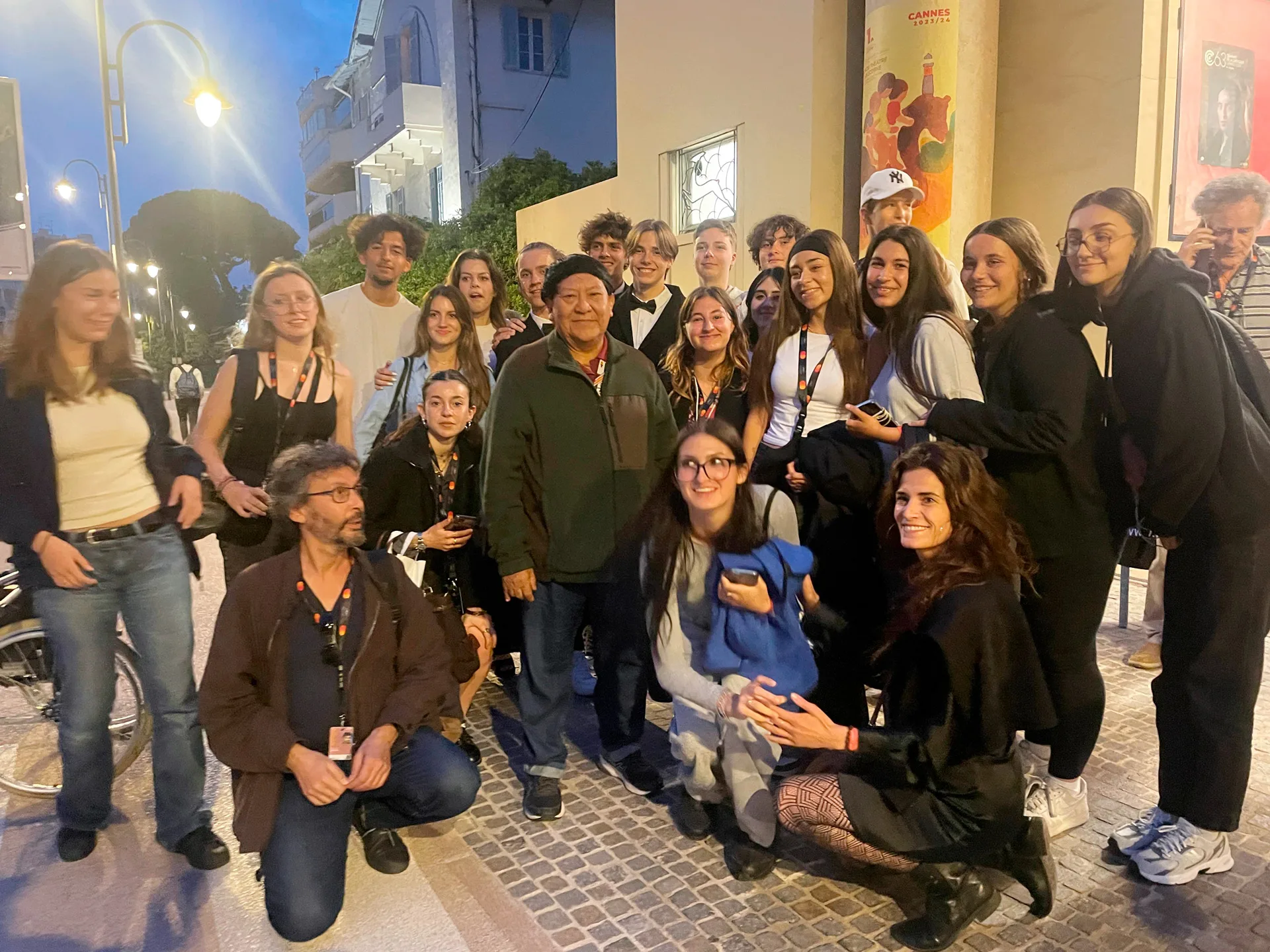
Fascinated by what Davi Kopenawa had to say, these young French people wanted to continue the conversation with the shaman in Cannes. Photo: personal archives
The film showings at Cannes took place just weeks after Asian countries endured lethal waves of extreme heat and while floods drowned the southernmost part of Brazil. Earth had recently completed the 12 hottest months ever recorded by science, and France was also about to enter another period of higher-than-average temperatures, which have become more frequent during the European summer. Perhaps that’s why Davi Kopenawa’s prescient insights during the film left spectators so moved. Wearing a black tuxedo, bow tie, and white shirt – and bringing Yanomami culture to the red carpet with his beaded necklace and feather headdress – Kopenawa garnered applause and respectful looks wherever he went.
The film describes how, in Yanomami cosmology, the xapiripë spirits have long held up the sky, which had in earlier times fallen after a series of transgressions committed by the yaroripë (animal ancestors). When interviewed by SUMAÚMA, Kopenawa explained that back then “the rain never stopped; it was always overcast. So the shamans of that first time sent their xapiripë to contain the being of chaos.” In the documentary, he warns this might happen again as a result of the process triggered by the non-Indigenous, who are destroying the planet. “This is what dreams tell us shamans, when we sniff yãkoana. When the Earth is unexpectedly transformed, you can have as much money as you want, you can run with your money, but when the stormy winds come, you won’t be able to silence them. You’ll wonder what’s happening. Times of lamentation will come,” the shaman says in the film. A warning that becomes even more frightening when we see images of cities like Porto Alegre devastated by torrential rains that are exacerbated by the climate crisis – or when we live through these experiences ourselves.
Because of this future, now turning into the present and appearing as threats in the shaman’s dreams, and because of the mining invasion that has been threatening the genocide of the Yanomami for years, Kopenawa continues his mission of transmitting his people’s worldview to the non-Indigenous. “The law is still soft on miners, farmers, agribusiness, and the big mining companies. That’s why the destruction continues. If we spread our images and our words everywhere with the film, to Europe, Brazil, and elsewhere, many people will understand and will help the government be stricter with their laws to stop the destruction of Brazil’s forest-earth,” Kopenawa told SUMAÚMA.
The formula for the success both of the book, written in French and translated into at least five languages, and of the documentary, lies in bringing the audience closer to the Yanomami way of life. For Davi Kopenawa, this most recent experience on the European continent–from where the first napëpë set sail to subjugate and exploit his people–returns as art what had been offered to the Yanomami as violence. “Back then the Portuguese came from Europe, saying they had discovered this land where the Indigenous people lived, and they called it Brazil. But they didn’t discover anything, they just invaded! Now we’re the ones taking our film The Falling Sky to Europe, so it can be seen and heard by the huge numbers of non-Indigenous people living there! We want to spread our Yanomami word, returning it to all corners of their world! We want them to get smarter and decide they should help, so whites will stop destroying our forest-earth!”
These words, like arrows, were released and seem to have reached at least the young people, who already understand the future lurking in the present.
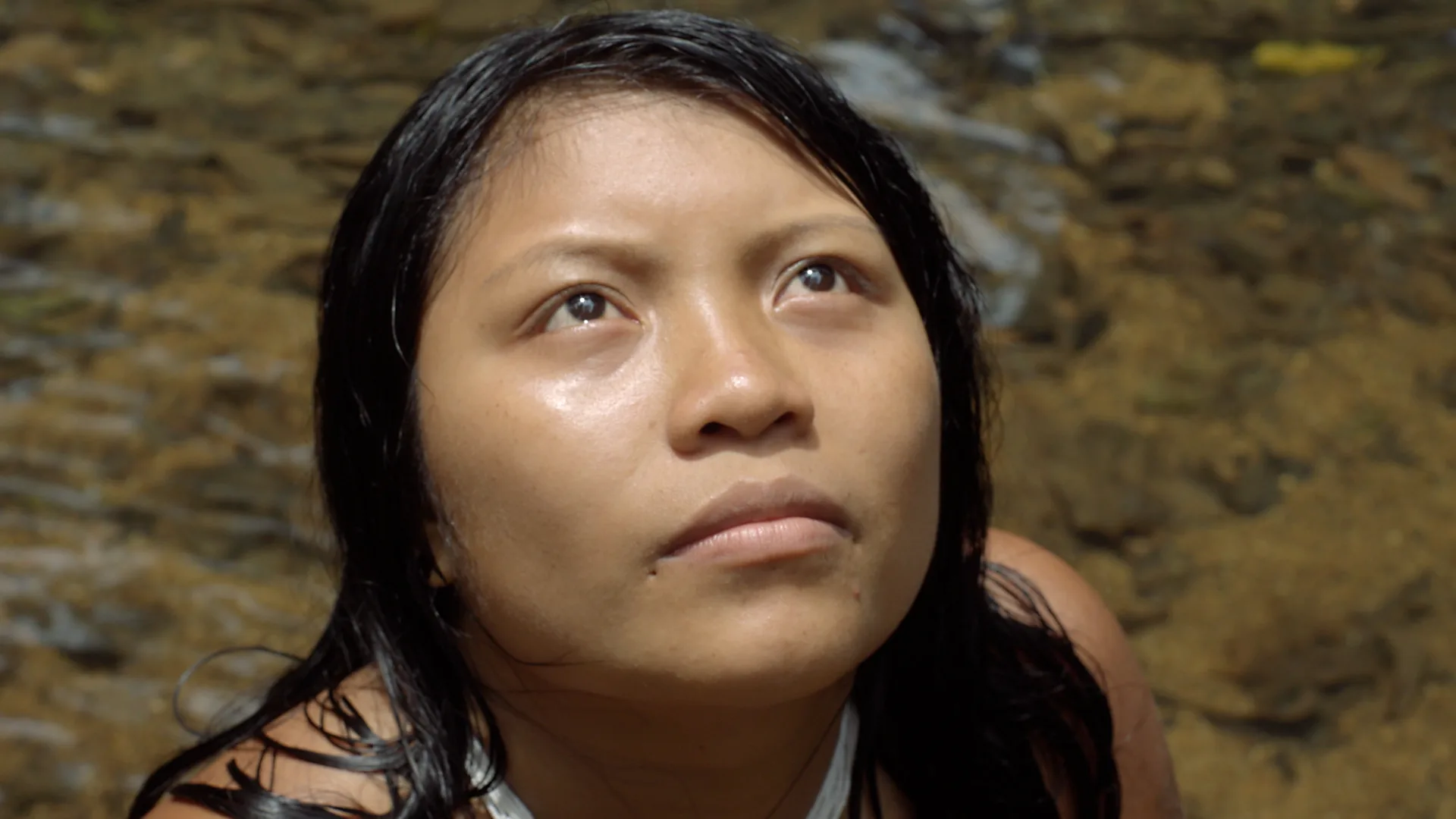
The Falling Sky sends a warning about the threats the Yanomami have suffered over the last decades. Photo: still from the documentary
Report and text: Jaqueline Sordi
Editing: Talita Bedinelli
Photo Editor: Lela Beltrão
Fact-checker: Douglas Maia and Plínio Lopes
Proofreader (Portuguese): Valquíria Della Pozza
Spanish translation: Meritxell Almarza
English translation: Maria Jacqueline Evans
Copyediting and finishing: Natália Chagas
Editorial workflow: Viviane Zandonadi
News editor: Malu Delgado
Editor-in-chief: Talita Bedinelli
Editorial director: Eliane Brum

